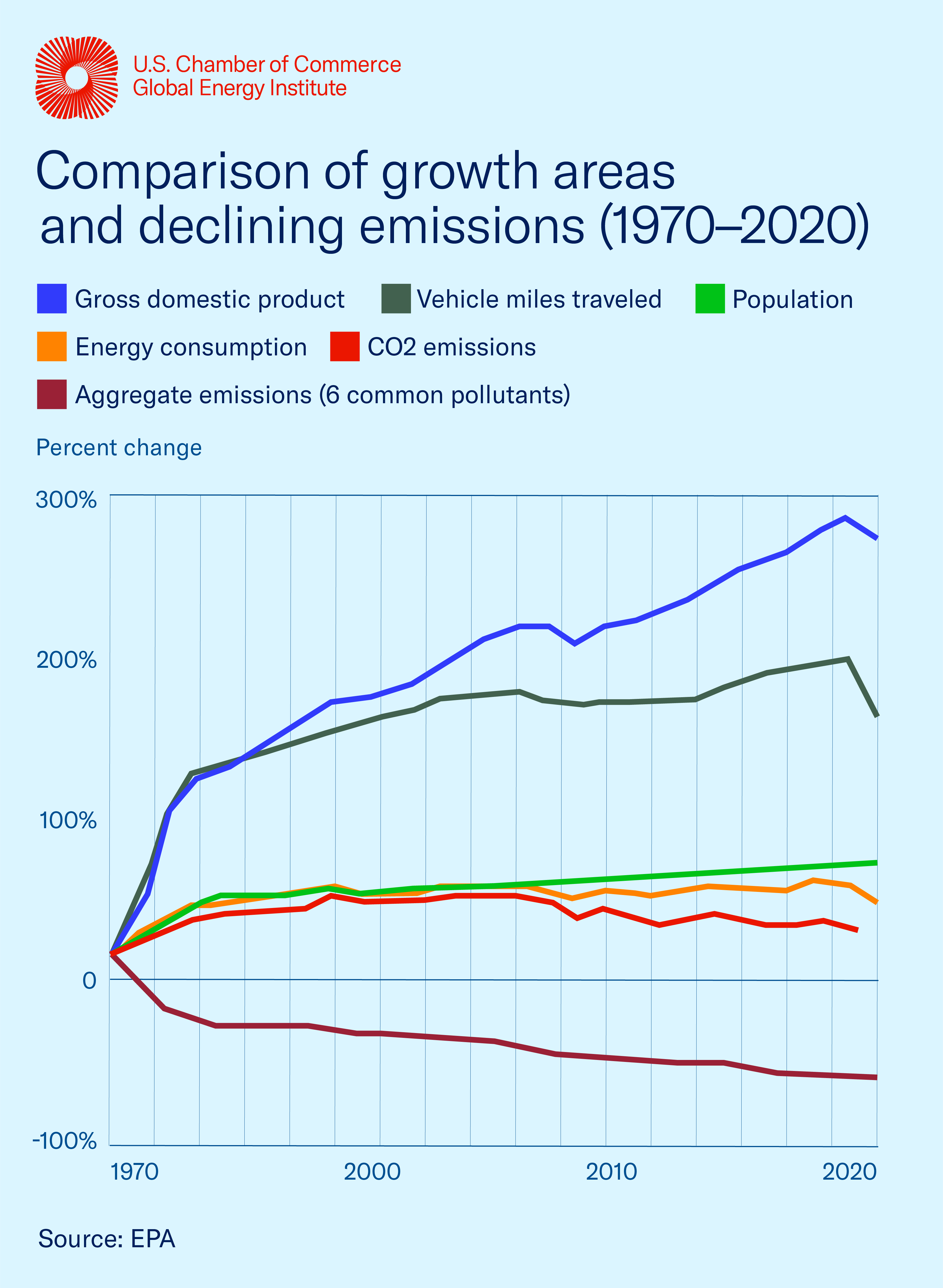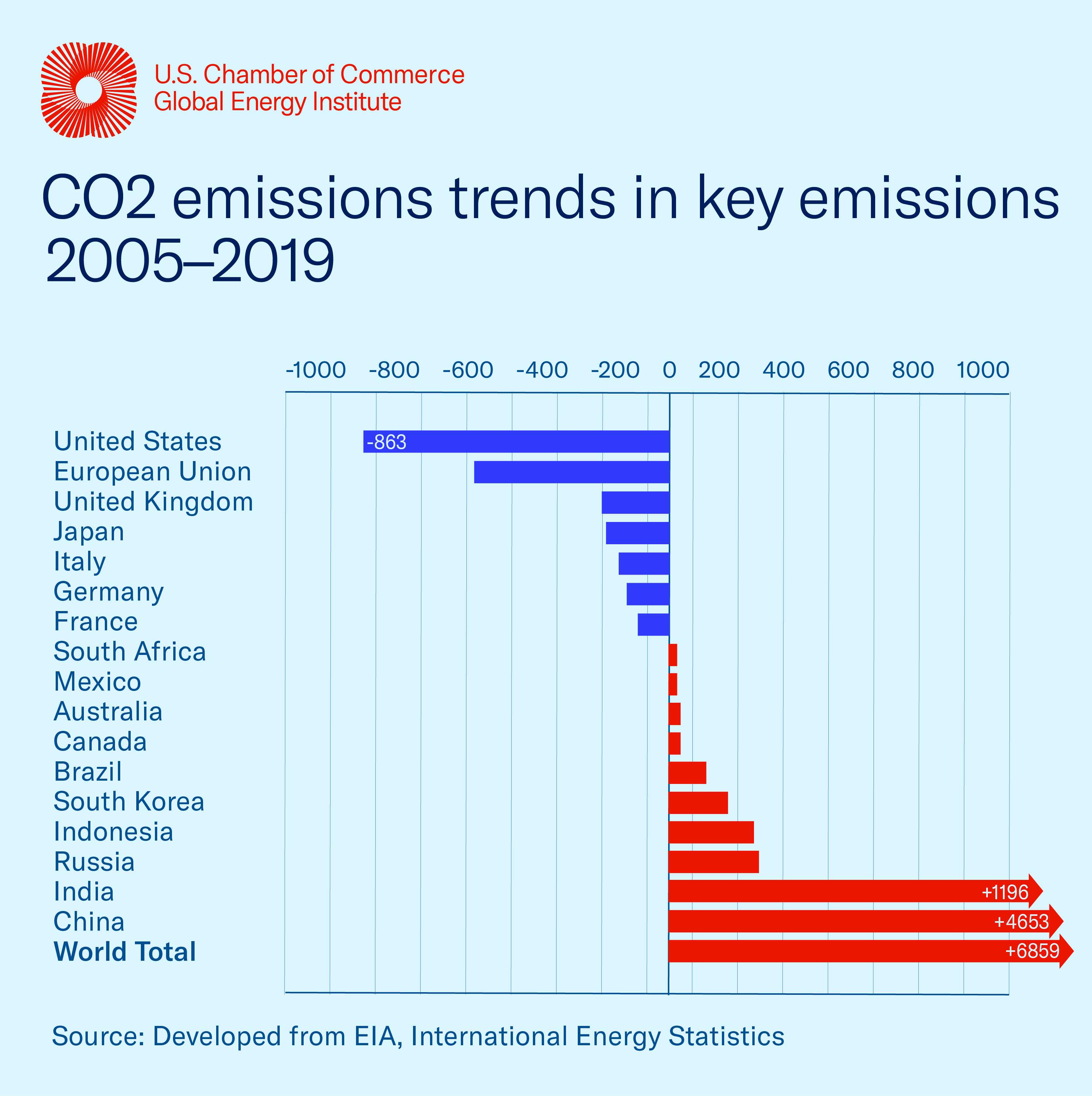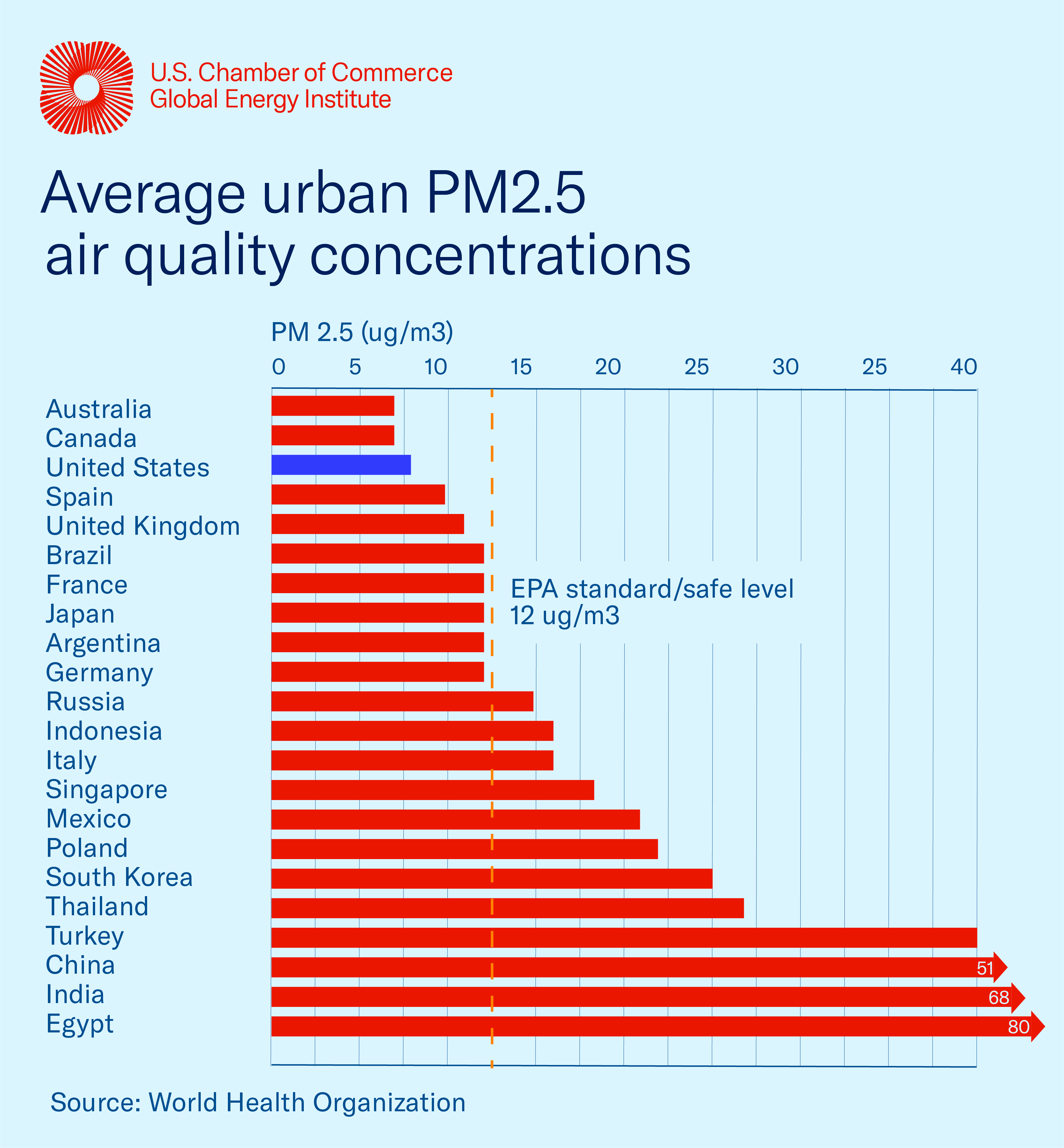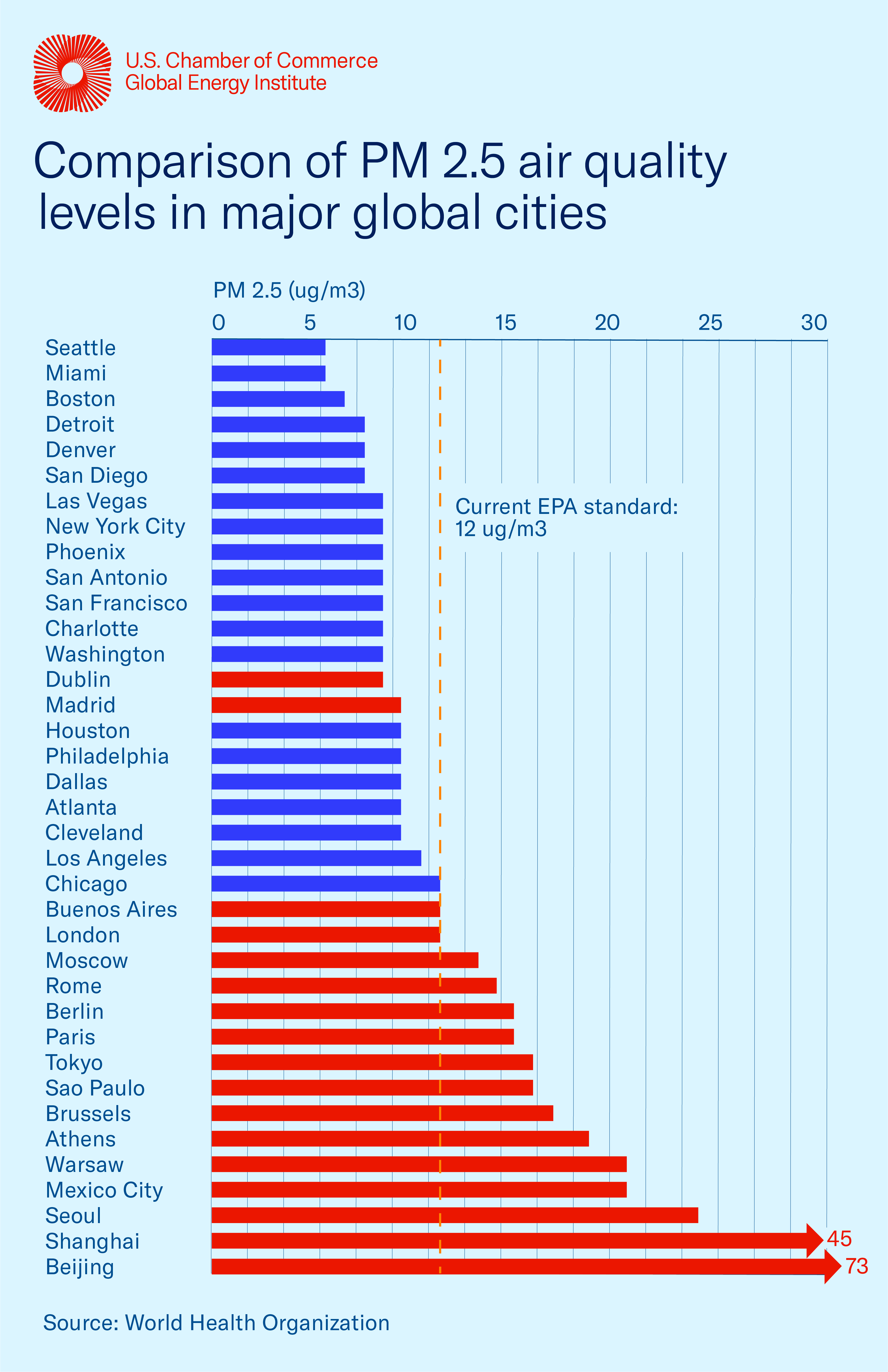There’s no doubt that many challenges remain in the global quest to reduce emissions and combat climate change. The American business community is fully committed to doing its part, with billions of dollars in investments and strong company commitments.
But that shouldn’t stop us from recognizing the incredible progress that the country has made to continuously improve the overall state of the environment.
This progress often doesn’t get much attention, and as a result the public remains pessimistic about the environment. In March, Gallup released its annual survey of Americans’ views on various environmental issues. The findings show that 59% of Americans believe that the quality of the environment in the U.S. is getting worse, versus only 35% that think it is getting better. With respect to air quality specifically, 75% of Americans say they worry about air pollution either a great deal or a fair amount. This pessimism has remained largely unchanged over the last 20 years of Gallup surveys.
The good news about the environment and air quality is what some refer to as “The Greatest Story Seldom Told”—namely, America’s underappreciated standing as having one of the best and cleanest environments in the world. As we celebrate Earth Day 2022, let’s take a look at some of these achievements.
Cleaner Electricity
The electric power sector is leading the way in domestic emissions reductions. Consider:
- According to EPA data, between 2005 and 2021, emissions of sulfur dioxide (SO2) and nitrogen oxides (NOX) from electricity generation were reduced by 91% and 79%, respectively.
- Between 2005 and 2021, power sector carbon dioxide (CO2) emissions fell by 35%, thanks primarily to expanded generation from both natural gas and renewables.
- Today, 39% of all U.S. power generation comes from emissions-free sources, including nuclear energy, hydropower, wind and solar energy.
- Nuclear energy remains the largest source of emissions-free electricity, with 94 reactors in 28 states generating about 55% of the nation’s emissions-free electricity.
- Emissions-free generation from renewable resources is expected to continue growing rapidly. The Energy Information Administration projects that, led by rapid deployment of solar and wind generation, the share of electricity produced from renewables will more than double from 21% in 2021 to 44% in 2050.
- Deployment of grid-scale battery storage is also accelerating. EIA predicts that by 2023 about 12 gigawatts of battery storage will be operational—up almost an order of magnitude from just 1.6 gigawatts in 2020.
- Energy efficiency does not get as much attention as supply-side resources, but it also contributes greatly to power sector environmental progress. It now takes 40% less energy to produce a dollar of GDP than it did in 1990.
- As we look to the future, the power sector will not only continue to get cleaner, it will enable transportation and other sectors to reduce their emissions as well.
- Moreover, the Energy Information Administration’s (EIA) latest 2022 forecast suggests that even as U.S. electricity generation grows by 6% between 2021 and 2030, we will nonetheless benefit from declining emissions of SO2 (25%), NOX (37%), mercury (22%), and CO2 (8%).
Cleaner Transportation
There has also been a great deal of progress on vehicle emissions. The increasing availability of hybrids and electric vehicles along with widespread use of more advanced powertrains, sensors and emissions control technologies have significantly improved the environmental footprint of the transportation sector. For example:
- Since 2000, EPA data shows that transportation emissions of ozone-forming nitrogen oxides and volatile organic compounds (VOCs) have declined by 73% and 81%, respectively, even as total vehicle miles traveled increased by 18%. During the same period, SO2 emissions from highway vehicles have decreased an incredible 95%.
- By 2025, it is expected that ozone-forming emissions of hydrocarbons and nitrogen oxides from new passenger vehicles will be nearly 98% lower than when vehicle emissions controls were first implemented.
- Vehicles sold today are on average 30% more fuel efficient than vehicles sold in 2004. In model year 2019, the auto industry produced more than 90 models of vehicles that achieve over 40 MPG.
- Meanwhile, advances in the efficiency and affordability of battery storage technologies have enabled the introduction of 28 different models of battery electric vehicles in the U.S., sparking a trend that is only expected to accelerate. By 2023, automakers will have invested more than $250 billion in electrification.
- Beyond passenger vehicles, U.S. industry is also making great strides to address emissions from the medium- and heavy-duty trucks that form the backbone of the U.S. supply chain. The latest generation of diesel-powered heavy-duty trucks reduce NOx and fine particles by 98% relative to previous generations of technology. Approximately 50% of heavy-duty vehicles on the road today are powered by these cleaner diesel engines, and truck and engine manufacturers are working to ensure continued efficiency gains in a manner that maximizes fleet turnover—a key factor in reducing emissions from trucking due to the long operational lives of diesel engines.
Cleaner Manufacturing and Industry
The contributions from America’s industrial sector are another overlooked contributor to air quality improvements.
- According to EPA’s National Emissions Inventory, emissions of SO2, NOx, and fine particulate matter (PM2.5) from industrial sector fuel combustion have declined by 81%, 62%, and 29%, respectively, since 2000.
- These successes are driven by efforts such as that of the American steel industry, which is among the cleanest in the world. Of the seven largest steel producing countries, the U.S. has the lowest CO2 emissions per ton of steel produced and has 60% lower emissions intensity than Chinese steel production.
- America’s cement manufacturers, which operate one of the most difficult-to-abate sectors with respect to CO2 emissions, recently committed to achieve carbon neutrality across the cement and concrete value chain by 2050.
- In another extremely difficult to decarbonize sector, the airline industry is collaborating with America’s refiners to meet net zero goals through commercialization and deployment of sustainable aviation fuels that can be blended up to 50% with traditional jet fuel while requiring no changes to aircraft technology.
- EPA data show a 34% reduction in releases of industrial chemicals between 2011 and 2020, led by a 54% reduction in ethylene oxide.
- Finally, the Chamber is proud to have worked collaboratively with industry and environmental organizations to recently achieve passage of the historic American Innovation and Manufacturing (AIM) Act, which will phase-down hydrofluorocarbons—or HFCs, which are used in applications such as aerosols, refrigeration, and air conditioning—by more than 85% over the next 15 years. American businesses are leading the push for U.S. ratification of this important international agreement.
Cleaner, Stronger Economy
These success stories only scratch the surface, but when added up across the economy, it should come as no surprise that nationwide progress on air quality has been equally impressive. As EPA highlights in its annual State of the Air report and in the striking chart below, between 1980 and 2020 the U.S. economy grew by 173% and our population grew by 46%, while aggregate emissions of key pollutants fell by 73%.
The chart above does not include greenhouse gas emissions (GHGs), but progress on this front is no less impressive. As shown below, the U.S. reduced economy-wide CO2 by 863 million metric tons between 2005 and 2019. That is far more than any country in the world, and the equivalent of taking 188 million cars off the road. Unfortunately, global emissions have increased rapidly during the same time period, illustrating the need for what we call the technology imperative: we must develop and commercialize emissions-reducing technologies that are cost-effective enough to promote global adoption. That’s why passage—and now implementation—of climate innovation measures in the Energy Act of 2020 and the Infrastructure Investment and Jobs Act have remained a top Chamber priority.
One final point on the state of U.S. air quality relative to the rest of the world: World Health Organization data on fine particulate matter (PM 2.5) levels—considered the best proxy for air quality comparisons—show the U.S. has some of the cleanest air on the planet, with urban PM 2.5 concentrations trailing only sparsely populated Canada and Australia among major countries. The same goes for city-level data, with major U.S. metropolitan areas (indicated in blue) generally exceeding the air quality of counterparts in Europe, Asia, and elsewhere.
There should be no doubt that more work needs to be done. A multitude of ambitious emissions targets exist at the state, local, and international levels, as well as from a growing number of businesses. The path to meeting them is likely to be uneven and dependent on promising but uncertain technological breakthroughs in the years ahead. But by assuming a global leadership role on climate and the environment, the United States has an opportunity to develop and export technologies that will help improve the entire planet, while supporting jobs and economic growth at home.
But this Earth Day, we should be encouraged by the progress that has been made to date and the collective investments and innovations that it has taken to get there and that will support even cleaner air and improved climate in the future. That’s something to celebrate—even if it is the greatest story still seldom told.





